Volume 31 Number 3 Winter 2009
In this Issue
Features
- Kenyon's Own
- Out of the Ashes
- Peirce Hall Reborn
- Ancient Empathy for Warriors
The Editor's Page
- Restoration Drama
Along Middle Path
- Going Solo
- Seen and Herd
- Jersey Boys (and girls)
- Sound Bites
- Kenyon in the News
- The Hot Sheet
- Gambier is Talking About...
Sports
- Sports Round-Up
- Gaining Something In Translation
Books
- The Heart of the Matter
- Reviews
Office Hours
- Musings: Beginner's Mind Over Matter
- Not in my Job Description: Lyrical Baker
- Burning Question for Jennifer Delahunty, Dean of Admissions and Financial Aid
Alumni News
- PTSD Sleuth
- Driveway Moments
- Obituaries
- Alumni Digest
The Last Page
- Peircing Memories
Reviews
Of Interest
William Aulenbach '54, What's Love Got to Do with It? Rev. Carl G. Carlozzi '62, Fire Department Religion: A Hopeful Story about Religious Coequality and Being Nice! More book news.
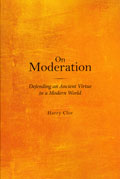 On Moderation: Defending an Ancient Virtue in a Modern World
On Moderation: Defending an Ancient Virtue in a Modern World
by Harry Clor
Baylor University Press
Over the course of thirty-plus years in the Kenyon classroom, Harry Clor earned the admiration of generations of students. A self-described "practitioner of liberal education at the college level," he famously approached the grand questions of political philosophy with humility, civility, and, yes, moderation. In the book under review, by analyzing the relationship of moderation to eudaimonia (the ancient Greek word for "happiness" or "human flourishing"), he resumes his life-long engagement with the hoary problem of how one might realize the flourishing life.
As Clor knows, "moderation" is scarcely a fashionable subject in today's world. That's why the subtitle is so apt, for it encapsulates both the task and the goal of the author: to defend the pertinence of an anciently praised attitude, disposition, or orientation against the doubts raised by newer-fangled ways of thinking. In addressing this task, Clor takes on many of the challenges to the classical view thrown up by moderation's famous enemies—preeminently Nietzsche, I suppose, but also Freud, Sartre, and (briefly) Jesus—while drawing upon the wisdom of such advocates of moderation as Tocqueville, Montaigne, Burke, and of course Aristotle.
Clor divides his discussion of the concept of moderation into three separate sections, assaying in turn its place in political life, in moral psychology, and in philosophy. But these sections are not hermetic boxes, and Clor's larger argument slowly gathers force as the reader sees earlier conclusions deepened, refined, and adjusted by the widening circle of discussants and challenges.
In his treatment of moderation's place in politics, Clor asserts—and who can disagree with him?—that any healthy polity pursues a cluster of goods which, in their extreme forms, are incompatible. He then emphasizes three points. First, that good leadership almost by definition entails moderation. Second, that moderation in leaders does not preclude decisiveness (examples include Roosevelt and Churchill). And third, that some regimes—those with settled laws, venues for discussion of public matters, and separation of church and state—are likelier to produce good leaders than others.
In discussing moral psychology, Clor focuses on the tension that exists between moderation's tendency to chasten enthusiasms and the claims—extravagantly commended in our own day as paths to happiness—of such presumably immoderate imperatives as a need for mastery, an avidness for adventure, or a submission to love. He gives special attention to the last imperative, for it poses the greatest conundrum. How, he provocatively asks, can there be eudaimonia without love? And why then would anyone want to moderate a passion that almost everyone regards as central to happiness? Besides, he remarks in the great throw-away line, "love does not calculate."
Clor's answer is complicated, involving the argument that a life cannot flourish if it is possessed by something else. And so in the end, though acknowledging that desire has its moments of irresistible yielding (the explicit reference here is to sexual union), Clor reaffirms the importance of self-mastery, arguing that character is the essential element in the realization of a love that lets life flourish; for character—by which, following Aristotle, he means inner discipline and outer reliability—not only lets one assess others before one is captured by love but also serves to make one worthy of someone else's love.
Clor's treatment of philosophy seeks basically to refute the epistemological challenge of postmodernism. How, its exponents ask, can one hope to reason about moderation when reality is socially constructed, when all values are subjective? Though Clor relishes demonstrating how various postmodern thinkers smuggle planted value judgments into their work, in the end he dismisses the postmodern challenge on the indirect (but to my mind quite adequate) grounds that a theory that is fatally self-contradictory cannot command our respect.
Four final points may be made. First, Clor observes the cardinal rule of inquiry by being eminently fair to all his opponents; in fact, he finds something of value in every challenger. Second, all his arguments rest on the assumption that that thing we casually call human nature, with its intricate mixture of the good and the bad, really exists. This aggregation of capacities and needs that stamps us as human may undergo change over time, it is certainly vastly complicated, and it defies precise calculation. But because it helps define the dimensions of our moral universe, conclusions about human matters which ignore that reality cannot be valid.
Third, he also assumes that within each adult there exists a potentially transcending agency that in some degree monitors and appraises the forces that operate on us; and this agency can, within limits, choose the direction of our activities. In sum, we are not just conscious automatons. (Clor does not engage with the challenge of neuroscience in this book. The next one, perhaps?) Fourth, all of these conclusions are appropriately tentative. The pursuit of eudaimonia does not, in Clor's eyes, allow for pontification.
This is a grand read. Whether it persuades probably depends upon the disposition of the reader. But it is hard to imagine a mind being unmarked by an encounter with the searching, clear, and humane arguments of Harry Clor.
—Reed Browning, professor emeritus of history
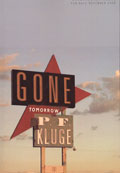 Gone Tomorrow
Gone Tomorrow
by P.F. Kluge '64
Overlook Press
A college writer-in-residence lives with a struggle embedded in his title. Will the "residential" part of his career—the teaching, the demands of students and colleagues, the institutional distractions—crowd out the writing? For George Canaris, the central character in P.F. Kluge's new novel, it's the question of a lifetime, suggesting wider questions about the writing life, the teaching life, his life story and family history. Deeper questions, too: about how writing matters, how a life matters.
Canaris has already earned some literary fame when he arrives on the campus of an unnamed hilltop college in rural Ohio. (Yes, Kenyon readers will chuckle and wince.) He's expected to stay maybe a year while finding some momentum for his next project, a much-anticipated but still unwritten magnum opus rooted in the pre-war central Europe that his parents fled. But the project languishes as Canaris settles in, the "writer who taught" slowly becoming "the teacher who used to write." The manuscript, which everyone comes to know as "the Beast"—and which may not even exist—will haunt Canaris, in private and public, through the more than thirty years he spends at the college.
The book is adroitly constructed. It opens with Canaris' perhaps mysterious death, and the initial narrator is Mark May, another bookish academic sojourner who finds that he's been named the elder writer's literary executor. Eagerly hunting for the legendary Beast among Canaris's effects, May discovers instead another manuscript, Gone Tomorrow. It's a journal/memoir of sorts, started just a year earlier—when Canaris learns that the college is forcing him to retire—and completed shortly before his death.
Breaking news and apologia pro vita sua, this unexpected document alternates between the "now" of 2005-06, Canaris' controversial final year at the college, and "then," a retracing of his entire career as writer, teacher, and lover. While shifting between present and past, the book also moves away from Ohio—most crucially to the Sudeten-German spa city of Karlsbad, Czechoslovakia, Canaris' birthplace and the emotional-cultural wellspring of the Beast—and then back again.
Both the framing device (the book within a book) and the shifts in time and place add texture to Kluge's exploration of concerns such as the value of memory and the importance of connection. Canaris, so out of place when he arrives at the college, becomes one of its fixtures, and yet he remains a kind of refugee, forever contemplating his personal journey, forever haunted by the sense of a vanished homeland, both literal and figurative.
The idea of haunting has an important place here. Canaris is haunted not only by his book and his former promise as an author but also by his family history, by the place of that history in his literary ambition, by a dead lover and dead colleagues, and by former students, including one who may be threatening to kill him. He plays the haunter as well—of Mark May, of students whom he inspired, and of the college that embarrasses itself in ousting him. The Beast, hovering over everything, becomes much more than a book.
Readers, especially those who have come to Gambier and stayed (for four years or more), will appreciate Kluge's feel for place. He writes of the "gray and penal" aspect of an Ohio winter; of how in an isolated village of endlessly recurring, intimately known cycles, one counts on the sun perpetually coming over a familiar ridge, so that "you tell the season of the year, down to the month, from the place where it [breaks] through the trees."
Sitting in the dead writer's chair, looking out over a river that Kenyon readers will recognize, Mark May wonders about Canaris, a "player in the game of memories," and the fate of the Beast. "Maybe he wrote, maybe he didn't," May muses. "But he must have considered the distances in his life, and the connections."
What became of the Beast? Gone Tomorrow ultimately gives a reasonably tidy answer. But it offers a larger, more resonant answer as well, entwined with those distances and connections.
—Dan Laskin
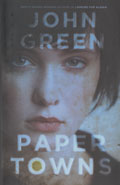 Paper Towns
Paper Towns
by John Green '00
Dutton
Like many teenagers, Quentin Jacobsen has a crush on his next-door neighbor. But Quentin and Margo Roth Spiegelman don't simply share an Orlando, Florida, subdivision; they share a disturbing memory. When they were both nine, they found a dead body in a nearby park: a suicide, a man who had shot himself over a lost love.
Now about to graduate from high school, Quentin and Margo have drifted apart. Quentin's a good kid, the wry and well-adjusted child of two psychologists, who doesn't "believe in prom." Margo's a repeat runaway, an attention seeker, beautiful, popular, and troubled. She's also a bit of a mystery, one Quentin finds himself pondering from afar, until the night she taps on his window and asks him to help her get revenge on her cheating boyfriend and best friend, just before she runs away for what might be a final time.
As in his previous young-adult novels, Looking for Alaska and An Abundance of Katherines, John Green deals with some heavy teen problems in Paper Towns, including depression, social alienation, suicide, and dropping out of school. That he manages to do so while maintaining a riveting, humorous storyline is testament to the voice and character of his narrator. Quentin is self-deprecating, insightful, and likeable. His journey to find Margo, both literally and metaphorically, takes us through the landscape of middle-class adolescent America, complete with abandoned suburbs, a Wikipedia-like online encyclopedia called Omnictionary, and a drunken superglue and beer-can accident.
In pursuing Margo, Quentin discovers the value of a rare quality: empathy. "Imagining isn't perfect," he realizes at one point. "But imagining being someone else, or the world being something else, is the only way in."
Green has a knack for imagining people, and finding a way in. He won praise and prizes for his previous books, including two American Library Association Best Book for Young Adults awards. Paper Towns is sure to gain equal admiration from readers young and not-so-young.
—T.V.
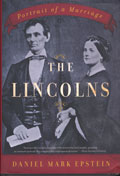 The Lincolns: Portrait of a Marriage
The Lincolns: Portrait of a Marriage
by Daniel Mark Epstein '70
Ballantine Books
Set aside any preconceptions you may have about Abraham Lincoln. In the first few pages of Daniel Mark Epstein's new biography, we learn that the man portrayed in popular culture as a humorless, top-hat-wearing stiff had quite a romantic streak, and that he nearly made a fool of himself courting Mary Todd—or Molly, as he called her.
"She was a bright-eyed, buxom maiden of twenty-one with glowing skin, abundant auburn hair, and shapely arms and shoulders, which she displayed to the limit the fashion would allow," Epstein writes.
Contemporaries described her as "the very creature of excitement," and "one who could make a bishop forget his prayers." This "creature" could have had the pick of any number of promising bachelors. To the chagrin of her family, she chose a lowly born thirty-three-year-old, a man who was a member of the House of Representatives but was socially awkward, and also a foot taller than she.
Epstein brings history to life with details such as these, painting a remarkable portrait of the Lincolns as a passionate couple. While many historians emphasize Mary Todd's social ambitions, excessive clothes shopping, and tempestuous nature, especially in the wake of the death of three of the couple's sons, Epstein describes her intense political involvement and hospitality. He digs up newspaper articles, letters, and household records that detail the couple's flirtatious interactions. The evident closeness of their early years brings a new poignancy to the story of Lincoln's political triumphs, struggles, and tragic assassination.
As for that top hat? It was a gift, and, according to Epstein, Lincoln's adoption of it shows that he shared at least a bit of the clothes obsession attributed to his wife.
—T.V.
 Sex in an Age of Technological Reproduction: ICSI and Taboos
Sex in an Age of Technological Reproduction: ICSI and Taboos
by Carl Djerassi '43 H'58
University of Wisconsin Press
Few people can claim to have influenced the course of society as much as Carl Djerassi. Dubbed one of the "fathers of the Pill," Djerassi helped develop the progestin norethindrone, which led to oral contraceptives for women. In the decade since he retired from practicing and teaching chemistry, Djerassi has taken up art, establishing an artist's colony for women, writing a novel, and writing and producing plays.
In ICSI and Taboos, published in a single volume under the title Sex in an Age of Technological Reproduction, Djerassi uses the dramatic format to tackle some of the issues he helped create with science. ICSI—the title is an acronym for intracytoplasmic sperm injection—pits Isabel Youngblood, a combative female television talk-show host, against Dr. Felix Frankenthaler, the fictional co-inventor of the procedure. As Youngblood fans the flames of controversies brought up by ICSI—including what to do with "extra" inseminated eggs that are not implanted in the womb, and whether gender selection is acceptable—Frankenthaler attempts to put out fires by explaining the science of the procedure. This "science-in-theatre," as Djerassi calls it in the book's preface, is a way to "smuggle scientific issues into the minds of an uninterested or even antagonistic public, by means of the most dialogic form of literature, drama."
The book's second play, Taboos, performs this function even more engagingly. A lesbian couple in San Francisco decide to get pregnant. To celebrate the occasion, one of the women, Sally, invites her conservative Christian brother Max for dinner, in the hopes that he'll warm to this idea of family. Max longs for a child of his own, but his wife Priscilla can't agree to artificial insemination because of her religious beliefs.
By the end of Taboos, the concept of family has grown to embrace a much larger—and more confusing—definition, and everyone's beliefs have been called into question. In articulating their arguments, the characters echo issues that stretch the contemporary fabric of American society. And yet it's their personal stories we're interested in, which is the essential truth of politics. The personal is political, even when it comes to science.
—T.V.
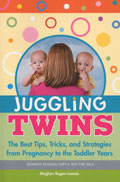 Juggling Twins: The Best Tips, Tricks, and Strategies from Pregnancy to the Toddler Years
Juggling Twins: The Best Tips, Tricks, and Strategies from Pregnancy to the Toddler Years
by Meghan Regan-Loomis '86
Sourcebooks
Congratulations! Congratulations!
What to do if everything comes up baby times two? Twin births are much more common than they used to be—up by 70 percent since 1980, according to some figures—and Meghan Regan-Loomis is among the multiply blessed. In Juggling Twins, she shares her hard-won knowledge with parents-to-be.
The chatty, engaging book is full of good practical advice. You'll find a list of items you'll need (e.g., two car baby mirrors, hooded baby towels, breast pump), suggestions on what kind of prenatal party to throw (a diaper party, where guests bring diapers as gifts: you'll need a lot of them), advice on establishing a sleep routine, and a primer on how to nurse two babies at once.
Regan-Loomis injects humor into the how-to (for example, how to respond to the bajillionth "oh, twins" comment: "What are you talking about? Do you see two?"), and even has ideas for how you can carve out some much-needed alone time. After all, by the end of the first month, you may be seeing quadruple.
—T.V.
Gambier, Ohio 43022
(740) 427-5158

 Delicious
Delicious Facebook
Facebook StumbleUpon
StumbleUpon Digg
Digg reddit
reddit